E-Technologies in Business: Changes, Risks, and Mitigation Essay
VerifiedAdded on 2023/06/09
|9
|2738
|455
Essay
AI Summary
This essay examines the profound impact of e-technologies on modern business operations, highlighting how these technologies have reshaped organizational functionality, expanded business reach, and enhanced efficiency. It discusses the role of technology suppliers in maintaining service quality and addressing the risks associated with these technologies. The essay also explores the benefits of technology in human resources, communication, marketing, and branding, emphasizing the contributions of the internet and social media. Furthermore, it analyzes the impact of technology at the macro level, including its role in global market expansion and research and development. The essay concludes by discussing the importance of risk management and the measures technology suppliers can adopt to mitigate threats, such as security firewalls, error detection, encryption methods, and advanced security systems. Desklib offers this essay and many other resources to aid students in their studies.
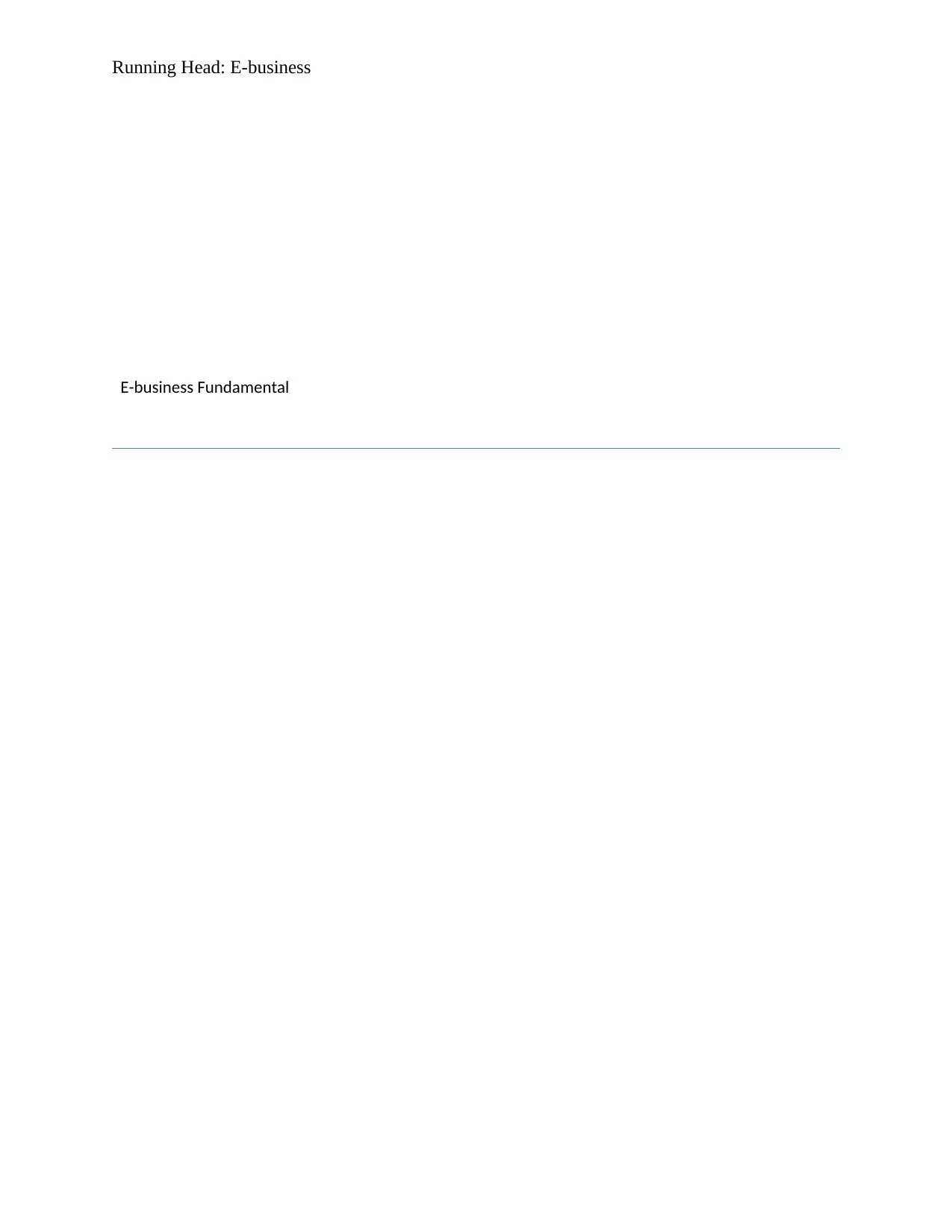
Running Head: E-business
E-business Fundamental
E-business Fundamental
Paraphrase This Document
Need a fresh take? Get an instant paraphrase of this document with our AI Paraphraser
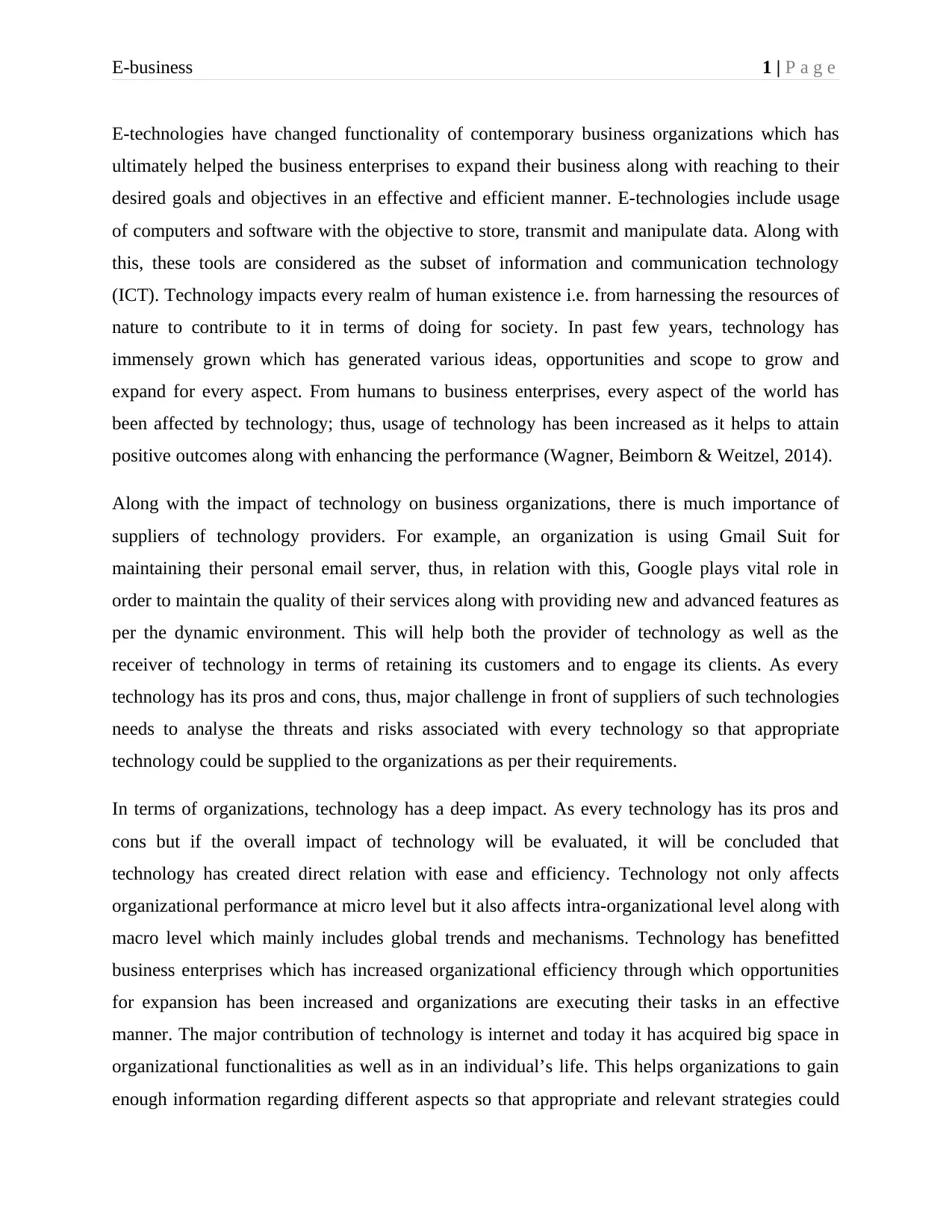
E-business 1 | P a g e
E-technologies have changed functionality of contemporary business organizations which has
ultimately helped the business enterprises to expand their business along with reaching to their
desired goals and objectives in an effective and efficient manner. E-technologies include usage
of computers and software with the objective to store, transmit and manipulate data. Along with
this, these tools are considered as the subset of information and communication technology
(ICT). Technology impacts every realm of human existence i.e. from harnessing the resources of
nature to contribute to it in terms of doing for society. In past few years, technology has
immensely grown which has generated various ideas, opportunities and scope to grow and
expand for every aspect. From humans to business enterprises, every aspect of the world has
been affected by technology; thus, usage of technology has been increased as it helps to attain
positive outcomes along with enhancing the performance (Wagner, Beimborn & Weitzel, 2014).
Along with the impact of technology on business organizations, there is much importance of
suppliers of technology providers. For example, an organization is using Gmail Suit for
maintaining their personal email server, thus, in relation with this, Google plays vital role in
order to maintain the quality of their services along with providing new and advanced features as
per the dynamic environment. This will help both the provider of technology as well as the
receiver of technology in terms of retaining its customers and to engage its clients. As every
technology has its pros and cons, thus, major challenge in front of suppliers of such technologies
needs to analyse the threats and risks associated with every technology so that appropriate
technology could be supplied to the organizations as per their requirements.
In terms of organizations, technology has a deep impact. As every technology has its pros and
cons but if the overall impact of technology will be evaluated, it will be concluded that
technology has created direct relation with ease and efficiency. Technology not only affects
organizational performance at micro level but it also affects intra-organizational level along with
macro level which mainly includes global trends and mechanisms. Technology has benefitted
business enterprises which has increased organizational efficiency through which opportunities
for expansion has been increased and organizations are executing their tasks in an effective
manner. The major contribution of technology is internet and today it has acquired big space in
organizational functionalities as well as in an individual’s life. This helps organizations to gain
enough information regarding different aspects so that appropriate and relevant strategies could
E-technologies have changed functionality of contemporary business organizations which has
ultimately helped the business enterprises to expand their business along with reaching to their
desired goals and objectives in an effective and efficient manner. E-technologies include usage
of computers and software with the objective to store, transmit and manipulate data. Along with
this, these tools are considered as the subset of information and communication technology
(ICT). Technology impacts every realm of human existence i.e. from harnessing the resources of
nature to contribute to it in terms of doing for society. In past few years, technology has
immensely grown which has generated various ideas, opportunities and scope to grow and
expand for every aspect. From humans to business enterprises, every aspect of the world has
been affected by technology; thus, usage of technology has been increased as it helps to attain
positive outcomes along with enhancing the performance (Wagner, Beimborn & Weitzel, 2014).
Along with the impact of technology on business organizations, there is much importance of
suppliers of technology providers. For example, an organization is using Gmail Suit for
maintaining their personal email server, thus, in relation with this, Google plays vital role in
order to maintain the quality of their services along with providing new and advanced features as
per the dynamic environment. This will help both the provider of technology as well as the
receiver of technology in terms of retaining its customers and to engage its clients. As every
technology has its pros and cons, thus, major challenge in front of suppliers of such technologies
needs to analyse the threats and risks associated with every technology so that appropriate
technology could be supplied to the organizations as per their requirements.
In terms of organizations, technology has a deep impact. As every technology has its pros and
cons but if the overall impact of technology will be evaluated, it will be concluded that
technology has created direct relation with ease and efficiency. Technology not only affects
organizational performance at micro level but it also affects intra-organizational level along with
macro level which mainly includes global trends and mechanisms. Technology has benefitted
business enterprises which has increased organizational efficiency through which opportunities
for expansion has been increased and organizations are executing their tasks in an effective
manner. The major contribution of technology is internet and today it has acquired big space in
organizational functionalities as well as in an individual’s life. This helps organizations to gain
enough information regarding different aspects so that appropriate and relevant strategies could
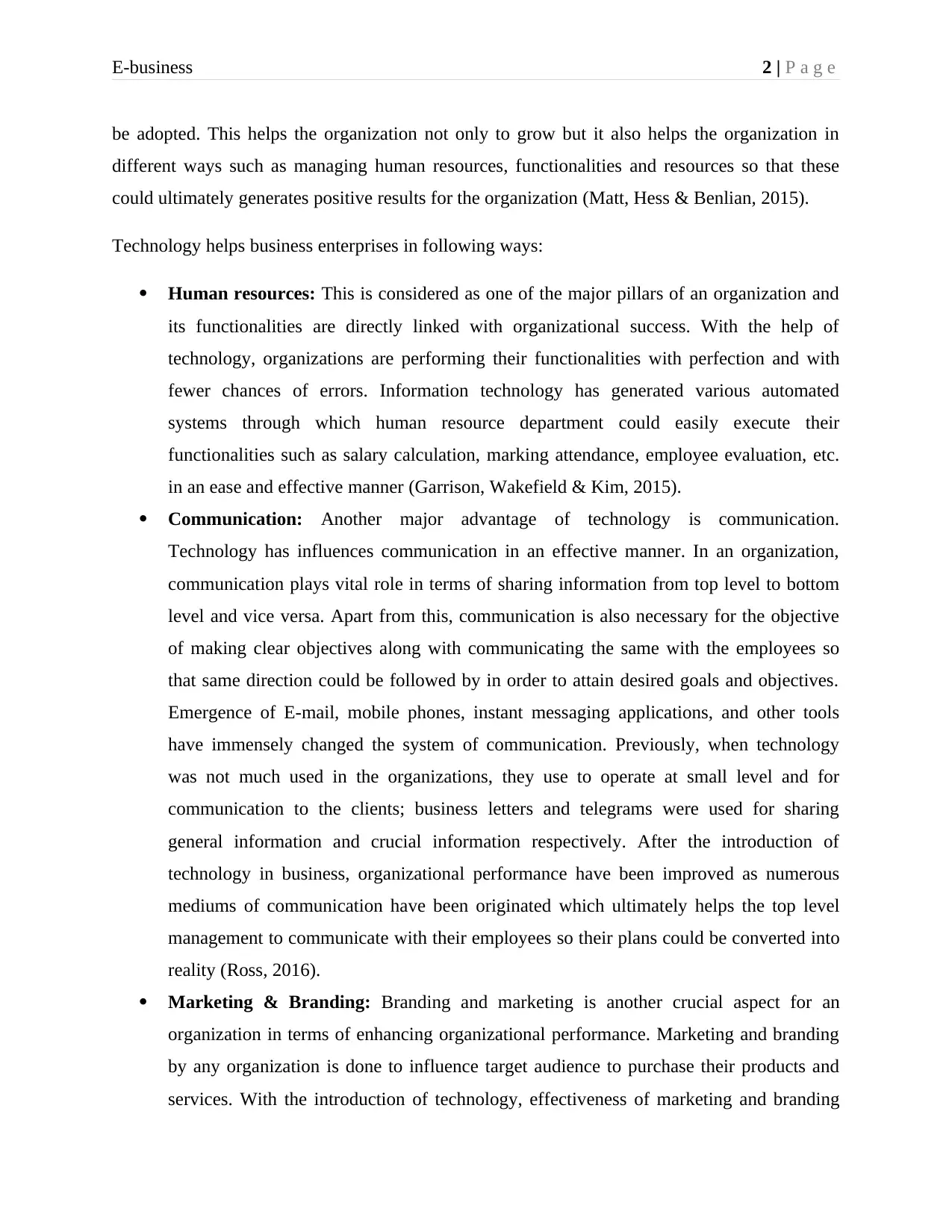
E-business 2 | P a g e
be adopted. This helps the organization not only to grow but it also helps the organization in
different ways such as managing human resources, functionalities and resources so that these
could ultimately generates positive results for the organization (Matt, Hess & Benlian, 2015).
Technology helps business enterprises in following ways:
Human resources: This is considered as one of the major pillars of an organization and
its functionalities are directly linked with organizational success. With the help of
technology, organizations are performing their functionalities with perfection and with
fewer chances of errors. Information technology has generated various automated
systems through which human resource department could easily execute their
functionalities such as salary calculation, marking attendance, employee evaluation, etc.
in an ease and effective manner (Garrison, Wakefield & Kim, 2015).
Communication: Another major advantage of technology is communication.
Technology has influences communication in an effective manner. In an organization,
communication plays vital role in terms of sharing information from top level to bottom
level and vice versa. Apart from this, communication is also necessary for the objective
of making clear objectives along with communicating the same with the employees so
that same direction could be followed by in order to attain desired goals and objectives.
Emergence of E-mail, mobile phones, instant messaging applications, and other tools
have immensely changed the system of communication. Previously, when technology
was not much used in the organizations, they use to operate at small level and for
communication to the clients; business letters and telegrams were used for sharing
general information and crucial information respectively. After the introduction of
technology in business, organizational performance have been improved as numerous
mediums of communication have been originated which ultimately helps the top level
management to communicate with their employees so their plans could be converted into
reality (Ross, 2016).
Marketing & Branding: Branding and marketing is another crucial aspect for an
organization in terms of enhancing organizational performance. Marketing and branding
by any organization is done to influence target audience to purchase their products and
services. With the introduction of technology, effectiveness of marketing and branding
be adopted. This helps the organization not only to grow but it also helps the organization in
different ways such as managing human resources, functionalities and resources so that these
could ultimately generates positive results for the organization (Matt, Hess & Benlian, 2015).
Technology helps business enterprises in following ways:
Human resources: This is considered as one of the major pillars of an organization and
its functionalities are directly linked with organizational success. With the help of
technology, organizations are performing their functionalities with perfection and with
fewer chances of errors. Information technology has generated various automated
systems through which human resource department could easily execute their
functionalities such as salary calculation, marking attendance, employee evaluation, etc.
in an ease and effective manner (Garrison, Wakefield & Kim, 2015).
Communication: Another major advantage of technology is communication.
Technology has influences communication in an effective manner. In an organization,
communication plays vital role in terms of sharing information from top level to bottom
level and vice versa. Apart from this, communication is also necessary for the objective
of making clear objectives along with communicating the same with the employees so
that same direction could be followed by in order to attain desired goals and objectives.
Emergence of E-mail, mobile phones, instant messaging applications, and other tools
have immensely changed the system of communication. Previously, when technology
was not much used in the organizations, they use to operate at small level and for
communication to the clients; business letters and telegrams were used for sharing
general information and crucial information respectively. After the introduction of
technology in business, organizational performance have been improved as numerous
mediums of communication have been originated which ultimately helps the top level
management to communicate with their employees so their plans could be converted into
reality (Ross, 2016).
Marketing & Branding: Branding and marketing is another crucial aspect for an
organization in terms of enhancing organizational performance. Marketing and branding
by any organization is done to influence target audience to purchase their products and
services. With the introduction of technology, effectiveness of marketing and branding
⊘ This is a preview!⊘
Do you want full access?
Subscribe today to unlock all pages.

Trusted by 1+ million students worldwide
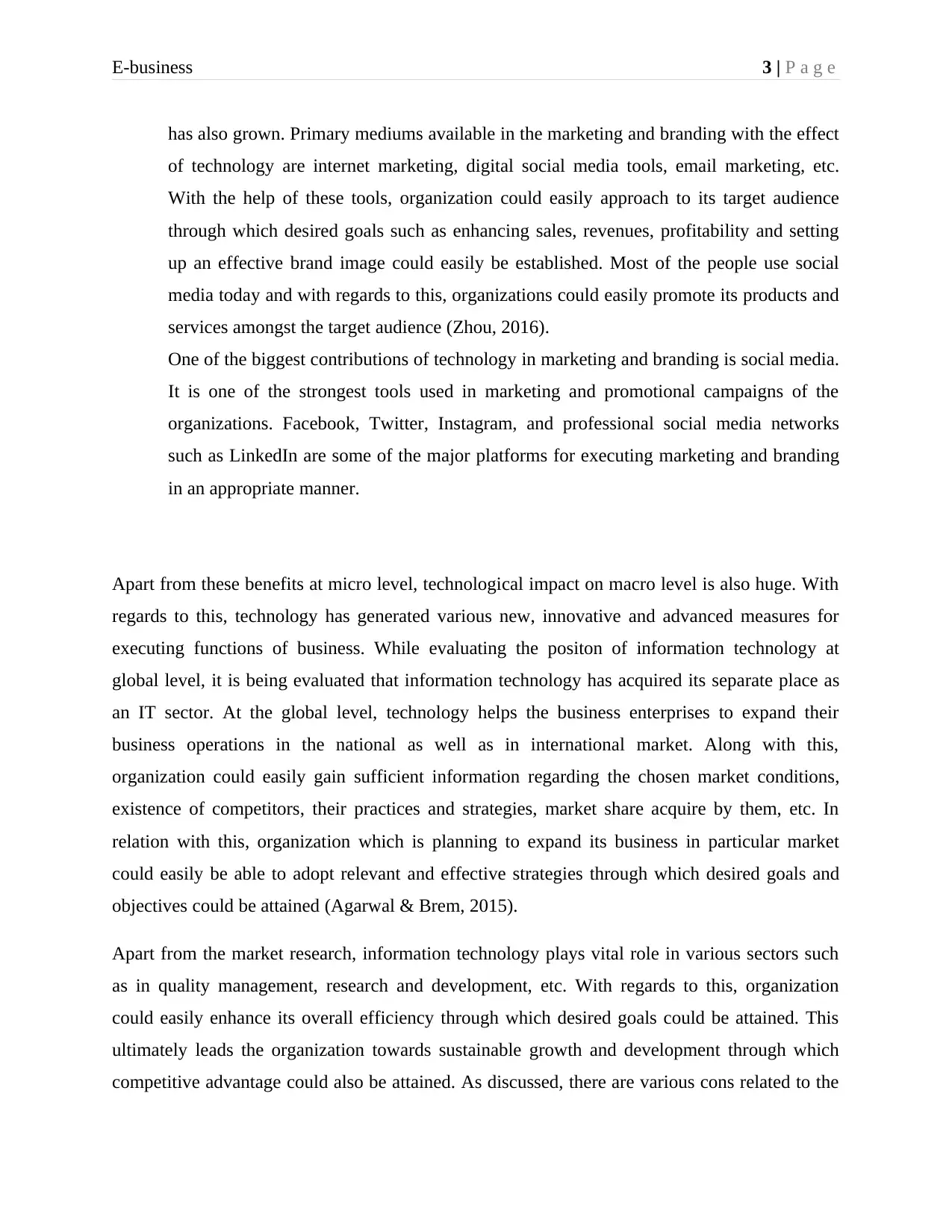
E-business 3 | P a g e
has also grown. Primary mediums available in the marketing and branding with the effect
of technology are internet marketing, digital social media tools, email marketing, etc.
With the help of these tools, organization could easily approach to its target audience
through which desired goals such as enhancing sales, revenues, profitability and setting
up an effective brand image could easily be established. Most of the people use social
media today and with regards to this, organizations could easily promote its products and
services amongst the target audience (Zhou, 2016).
One of the biggest contributions of technology in marketing and branding is social media.
It is one of the strongest tools used in marketing and promotional campaigns of the
organizations. Facebook, Twitter, Instagram, and professional social media networks
such as LinkedIn are some of the major platforms for executing marketing and branding
in an appropriate manner.
Apart from these benefits at micro level, technological impact on macro level is also huge. With
regards to this, technology has generated various new, innovative and advanced measures for
executing functions of business. While evaluating the positon of information technology at
global level, it is being evaluated that information technology has acquired its separate place as
an IT sector. At the global level, technology helps the business enterprises to expand their
business operations in the national as well as in international market. Along with this,
organization could easily gain sufficient information regarding the chosen market conditions,
existence of competitors, their practices and strategies, market share acquire by them, etc. In
relation with this, organization which is planning to expand its business in particular market
could easily be able to adopt relevant and effective strategies through which desired goals and
objectives could be attained (Agarwal & Brem, 2015).
Apart from the market research, information technology plays vital role in various sectors such
as in quality management, research and development, etc. With regards to this, organization
could easily enhance its overall efficiency through which desired goals could be attained. This
ultimately leads the organization towards sustainable growth and development through which
competitive advantage could also be attained. As discussed, there are various cons related to the
has also grown. Primary mediums available in the marketing and branding with the effect
of technology are internet marketing, digital social media tools, email marketing, etc.
With the help of these tools, organization could easily approach to its target audience
through which desired goals such as enhancing sales, revenues, profitability and setting
up an effective brand image could easily be established. Most of the people use social
media today and with regards to this, organizations could easily promote its products and
services amongst the target audience (Zhou, 2016).
One of the biggest contributions of technology in marketing and branding is social media.
It is one of the strongest tools used in marketing and promotional campaigns of the
organizations. Facebook, Twitter, Instagram, and professional social media networks
such as LinkedIn are some of the major platforms for executing marketing and branding
in an appropriate manner.
Apart from these benefits at micro level, technological impact on macro level is also huge. With
regards to this, technology has generated various new, innovative and advanced measures for
executing functions of business. While evaluating the positon of information technology at
global level, it is being evaluated that information technology has acquired its separate place as
an IT sector. At the global level, technology helps the business enterprises to expand their
business operations in the national as well as in international market. Along with this,
organization could easily gain sufficient information regarding the chosen market conditions,
existence of competitors, their practices and strategies, market share acquire by them, etc. In
relation with this, organization which is planning to expand its business in particular market
could easily be able to adopt relevant and effective strategies through which desired goals and
objectives could be attained (Agarwal & Brem, 2015).
Apart from the market research, information technology plays vital role in various sectors such
as in quality management, research and development, etc. With regards to this, organization
could easily enhance its overall efficiency through which desired goals could be attained. This
ultimately leads the organization towards sustainable growth and development through which
competitive advantage could also be attained. As discussed, there are various cons related to the
Paraphrase This Document
Need a fresh take? Get an instant paraphrase of this document with our AI Paraphraser

E-business 4 | P a g e
utilisation of technology, organization needs to manage a team that could be sufficient enough to
utilise an appropriate technology at right time so that tasks could be executed in an appropriate
manner as per the expectations (Webber, Raghu & Edwards, 2015).
In today’s business environment, business enterprises use technology mainly for storing
consumer’ s data, marketing and promotion, communication as well as for gaining relevant
information regarding the market’s environment. With regards to this, organizations requires to
avail cloud storage services in relation with storing consumers’ data so that the data could be
used in long run for producing products as per consumer’s demand as well as to attain
competitive advantage in the target market. In relevance with this, it is necessary for the
suppliers of the technology to analyse the risks and threats associated with the technologies so
that the companies which are availing the technologies could enjoy maximum benefit in order to
accomplish their desired goals and objectives (Renn, 2017).
Companies like Google, Amazon, Microsoft, etc. are some of the major players of cloud related
services and this technology has helped business companies to store plethora of data related to
their consumers and other sort of data. For providing these types of services, cloud operating
companies charge certain amount in order to keep their clients’ data secure, safe and ready to
access anytime from anywhere. When a company pays off for availing certain type of services,
there are certain obligations which should be fulfilled such as data will be secure, safe and it will
not be leaked, thus, it is crucial for the organization to analyse to determine appropriate risk and
threat factors so that organization could be able to gain desired goals and objectives along with
developing Hyperloop of positive synergies (Aitsi-Selmi¸et. al., 2016).
In order to overcome the threats and risks associated these technologies, suppliers of
technologies like cloud and server services needs to adopt certain effective and advanced
measures in order to develop their reliable image amongst their clients. For example, Facebook is
one of biggest cloud service provider but recently Facebook’s own data has been leaked due to
which Facebook is facing loss of financial as well as reputation goodwill. Following are certain
measures which could be adopted by the suppliers of technology in order to overcome with the
threats and risks associated with the technologies:
utilisation of technology, organization needs to manage a team that could be sufficient enough to
utilise an appropriate technology at right time so that tasks could be executed in an appropriate
manner as per the expectations (Webber, Raghu & Edwards, 2015).
In today’s business environment, business enterprises use technology mainly for storing
consumer’ s data, marketing and promotion, communication as well as for gaining relevant
information regarding the market’s environment. With regards to this, organizations requires to
avail cloud storage services in relation with storing consumers’ data so that the data could be
used in long run for producing products as per consumer’s demand as well as to attain
competitive advantage in the target market. In relevance with this, it is necessary for the
suppliers of the technology to analyse the risks and threats associated with the technologies so
that the companies which are availing the technologies could enjoy maximum benefit in order to
accomplish their desired goals and objectives (Renn, 2017).
Companies like Google, Amazon, Microsoft, etc. are some of the major players of cloud related
services and this technology has helped business companies to store plethora of data related to
their consumers and other sort of data. For providing these types of services, cloud operating
companies charge certain amount in order to keep their clients’ data secure, safe and ready to
access anytime from anywhere. When a company pays off for availing certain type of services,
there are certain obligations which should be fulfilled such as data will be secure, safe and it will
not be leaked, thus, it is crucial for the organization to analyse to determine appropriate risk and
threat factors so that organization could be able to gain desired goals and objectives along with
developing Hyperloop of positive synergies (Aitsi-Selmi¸et. al., 2016).
In order to overcome the threats and risks associated these technologies, suppliers of
technologies like cloud and server services needs to adopt certain effective and advanced
measures in order to develop their reliable image amongst their clients. For example, Facebook is
one of biggest cloud service provider but recently Facebook’s own data has been leaked due to
which Facebook is facing loss of financial as well as reputation goodwill. Following are certain
measures which could be adopted by the suppliers of technology in order to overcome with the
threats and risks associated with the technologies:
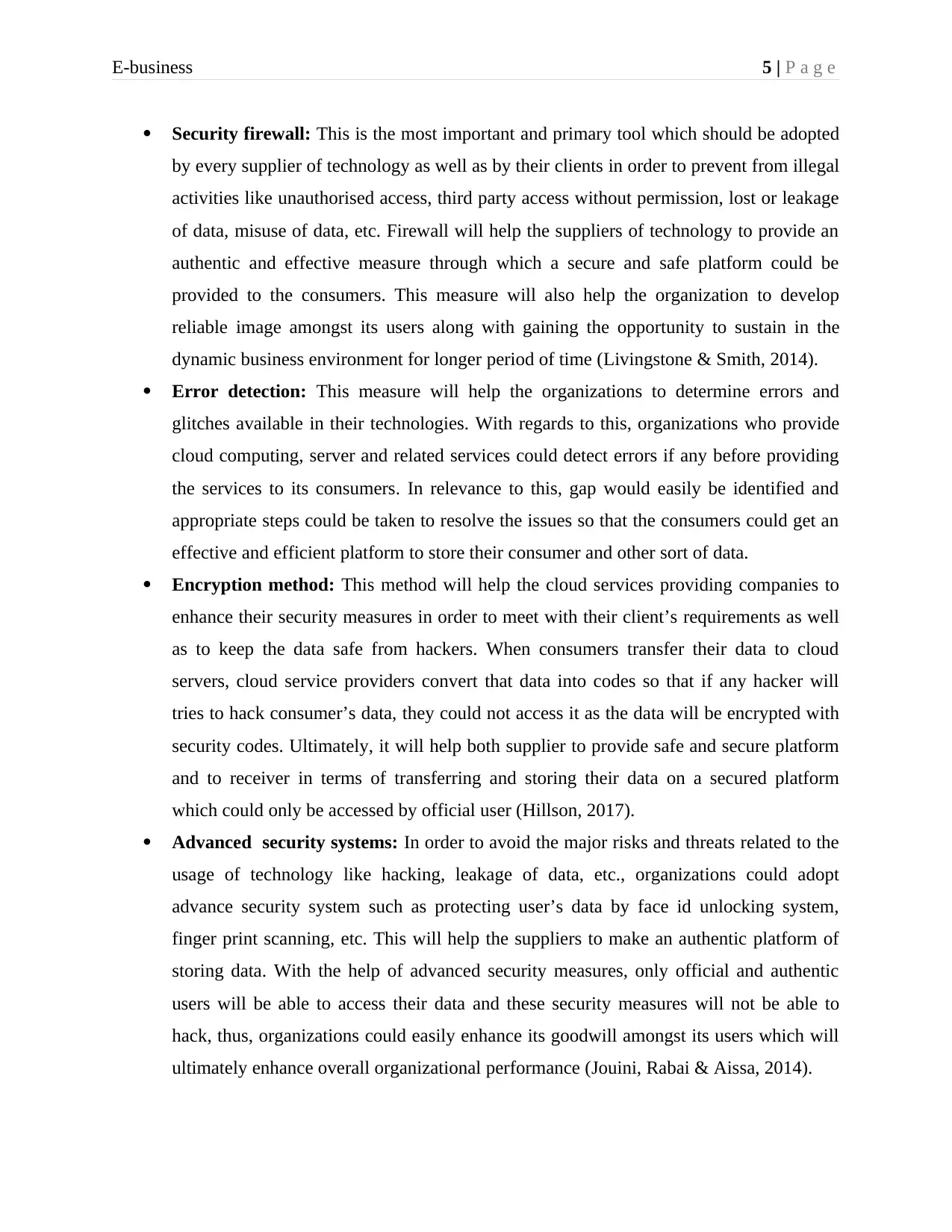
E-business 5 | P a g e
Security firewall: This is the most important and primary tool which should be adopted
by every supplier of technology as well as by their clients in order to prevent from illegal
activities like unauthorised access, third party access without permission, lost or leakage
of data, misuse of data, etc. Firewall will help the suppliers of technology to provide an
authentic and effective measure through which a secure and safe platform could be
provided to the consumers. This measure will also help the organization to develop
reliable image amongst its users along with gaining the opportunity to sustain in the
dynamic business environment for longer period of time (Livingstone & Smith, 2014).
Error detection: This measure will help the organizations to determine errors and
glitches available in their technologies. With regards to this, organizations who provide
cloud computing, server and related services could detect errors if any before providing
the services to its consumers. In relevance to this, gap would easily be identified and
appropriate steps could be taken to resolve the issues so that the consumers could get an
effective and efficient platform to store their consumer and other sort of data.
Encryption method: This method will help the cloud services providing companies to
enhance their security measures in order to meet with their client’s requirements as well
as to keep the data safe from hackers. When consumers transfer their data to cloud
servers, cloud service providers convert that data into codes so that if any hacker will
tries to hack consumer’s data, they could not access it as the data will be encrypted with
security codes. Ultimately, it will help both supplier to provide safe and secure platform
and to receiver in terms of transferring and storing their data on a secured platform
which could only be accessed by official user (Hillson, 2017).
Advanced security systems: In order to avoid the major risks and threats related to the
usage of technology like hacking, leakage of data, etc., organizations could adopt
advance security system such as protecting user’s data by face id unlocking system,
finger print scanning, etc. This will help the suppliers to make an authentic platform of
storing data. With the help of advanced security measures, only official and authentic
users will be able to access their data and these security measures will not be able to
hack, thus, organizations could easily enhance its goodwill amongst its users which will
ultimately enhance overall organizational performance (Jouini, Rabai & Aissa, 2014).
Security firewall: This is the most important and primary tool which should be adopted
by every supplier of technology as well as by their clients in order to prevent from illegal
activities like unauthorised access, third party access without permission, lost or leakage
of data, misuse of data, etc. Firewall will help the suppliers of technology to provide an
authentic and effective measure through which a secure and safe platform could be
provided to the consumers. This measure will also help the organization to develop
reliable image amongst its users along with gaining the opportunity to sustain in the
dynamic business environment for longer period of time (Livingstone & Smith, 2014).
Error detection: This measure will help the organizations to determine errors and
glitches available in their technologies. With regards to this, organizations who provide
cloud computing, server and related services could detect errors if any before providing
the services to its consumers. In relevance to this, gap would easily be identified and
appropriate steps could be taken to resolve the issues so that the consumers could get an
effective and efficient platform to store their consumer and other sort of data.
Encryption method: This method will help the cloud services providing companies to
enhance their security measures in order to meet with their client’s requirements as well
as to keep the data safe from hackers. When consumers transfer their data to cloud
servers, cloud service providers convert that data into codes so that if any hacker will
tries to hack consumer’s data, they could not access it as the data will be encrypted with
security codes. Ultimately, it will help both supplier to provide safe and secure platform
and to receiver in terms of transferring and storing their data on a secured platform
which could only be accessed by official user (Hillson, 2017).
Advanced security systems: In order to avoid the major risks and threats related to the
usage of technology like hacking, leakage of data, etc., organizations could adopt
advance security system such as protecting user’s data by face id unlocking system,
finger print scanning, etc. This will help the suppliers to make an authentic platform of
storing data. With the help of advanced security measures, only official and authentic
users will be able to access their data and these security measures will not be able to
hack, thus, organizations could easily enhance its goodwill amongst its users which will
ultimately enhance overall organizational performance (Jouini, Rabai & Aissa, 2014).
⊘ This is a preview!⊘
Do you want full access?
Subscribe today to unlock all pages.

Trusted by 1+ million students worldwide

E-business 6 | P a g e
From the aforesaid information, it could be concluded that e-technologies have significant
impact over organizational performance. In modern business environment, usage of e-
technologies have been grown up immensely and with regards to this, opportunities for
organizations have also been increased rapidly which ultimately helps the business enterprises to
expand their business appropriately in the domestic as well as in international market. This essay
concludes the impact of e-technologies over modern business operations along with the measures
taken by suppliers of these technologies to mitigate the threats and risks associated with these
technologies.
From the aforesaid information, it could be concluded that e-technologies have significant
impact over organizational performance. In modern business environment, usage of e-
technologies have been grown up immensely and with regards to this, opportunities for
organizations have also been increased rapidly which ultimately helps the business enterprises to
expand their business appropriately in the domestic as well as in international market. This essay
concludes the impact of e-technologies over modern business operations along with the measures
taken by suppliers of these technologies to mitigate the threats and risks associated with these
technologies.
Paraphrase This Document
Need a fresh take? Get an instant paraphrase of this document with our AI Paraphraser

E-business 7 | P a g e
References
Agarwal, N. and Brem, A., 2015. Strategic business transformation through technology
convergence: implications from General Electric's industrial internet initiative. International
Journal of Technology Management, 67(2-4), pp.196-214.
Aitsi-Selmi, A., Murray, V., Wannous, C., Dickinson, C., Johnston, D., Kawasaki, A., Stevance,
A.S. and Yeung, T., 2016. Reflections on a science and technology agenda for 21st century
disaster risk reduction. International Journal of Disaster Risk Science, 7(1), pp.1-29.
Garrison, G., Wakefield, R.L. and Kim, S., 2015. The effects of IT capabilities and delivery
model on cloud computing success and firm performance for cloud supported processes and
operations. International Journal of Information Management, 35(4), pp.377-393.
Hillson, D., 2017. Managing risk in projects. Routledge.
Jouini, M., Rabai, L.B.A. and Aissa, A.B., 2014. Classification of security threats in information
systems. Procedia Computer Science, 32, pp.489-496.
Livingstone, S. and Smith, P.K., 2014. Annual research review: Harms experienced by child
users of online and mobile technologies: The nature, prevalence and management of sexual and
aggressive risks in the digital age. Journal of child psychology and psychiatry, 55(6), pp.635-
654.
Matt, C., Hess, T. and Benlian, A., 2015. Digital transformation strategies. Business &
Information Systems Engineering, 57(5), pp.339-343.
Renn, O., 2017. Risk governance: coping with uncertainty in a complex world. Routledge.
Ross, D.F., 2016. Introduction to e-supply chain management: engaging technology to build
market-winning business partnerships. CRC Press.
References
Agarwal, N. and Brem, A., 2015. Strategic business transformation through technology
convergence: implications from General Electric's industrial internet initiative. International
Journal of Technology Management, 67(2-4), pp.196-214.
Aitsi-Selmi, A., Murray, V., Wannous, C., Dickinson, C., Johnston, D., Kawasaki, A., Stevance,
A.S. and Yeung, T., 2016. Reflections on a science and technology agenda for 21st century
disaster risk reduction. International Journal of Disaster Risk Science, 7(1), pp.1-29.
Garrison, G., Wakefield, R.L. and Kim, S., 2015. The effects of IT capabilities and delivery
model on cloud computing success and firm performance for cloud supported processes and
operations. International Journal of Information Management, 35(4), pp.377-393.
Hillson, D., 2017. Managing risk in projects. Routledge.
Jouini, M., Rabai, L.B.A. and Aissa, A.B., 2014. Classification of security threats in information
systems. Procedia Computer Science, 32, pp.489-496.
Livingstone, S. and Smith, P.K., 2014. Annual research review: Harms experienced by child
users of online and mobile technologies: The nature, prevalence and management of sexual and
aggressive risks in the digital age. Journal of child psychology and psychiatry, 55(6), pp.635-
654.
Matt, C., Hess, T. and Benlian, A., 2015. Digital transformation strategies. Business &
Information Systems Engineering, 57(5), pp.339-343.
Renn, O., 2017. Risk governance: coping with uncertainty in a complex world. Routledge.
Ross, D.F., 2016. Introduction to e-supply chain management: engaging technology to build
market-winning business partnerships. CRC Press.
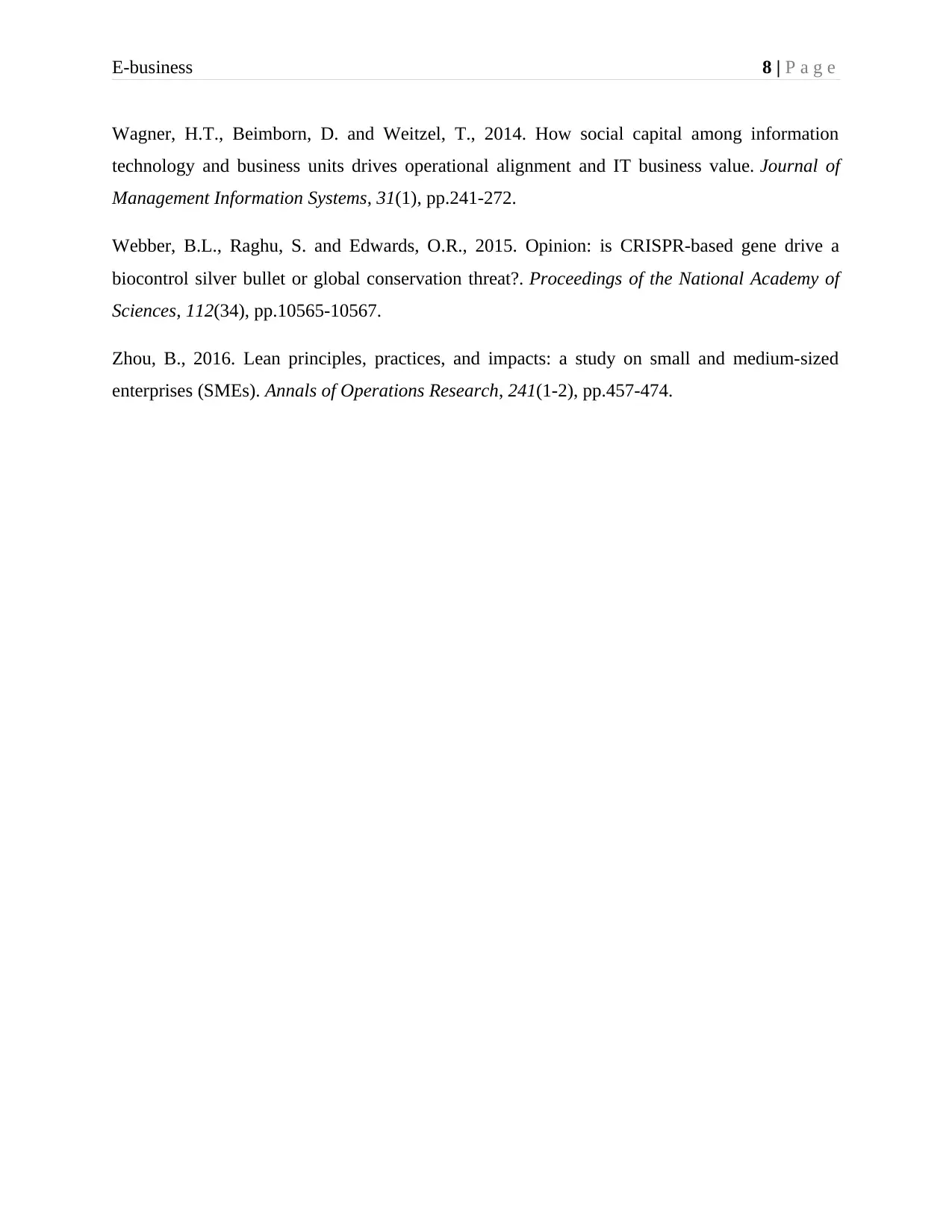
E-business 8 | P a g e
Wagner, H.T., Beimborn, D. and Weitzel, T., 2014. How social capital among information
technology and business units drives operational alignment and IT business value. Journal of
Management Information Systems, 31(1), pp.241-272.
Webber, B.L., Raghu, S. and Edwards, O.R., 2015. Opinion: is CRISPR-based gene drive a
biocontrol silver bullet or global conservation threat?. Proceedings of the National Academy of
Sciences, 112(34), pp.10565-10567.
Zhou, B., 2016. Lean principles, practices, and impacts: a study on small and medium-sized
enterprises (SMEs). Annals of Operations Research, 241(1-2), pp.457-474.
Wagner, H.T., Beimborn, D. and Weitzel, T., 2014. How social capital among information
technology and business units drives operational alignment and IT business value. Journal of
Management Information Systems, 31(1), pp.241-272.
Webber, B.L., Raghu, S. and Edwards, O.R., 2015. Opinion: is CRISPR-based gene drive a
biocontrol silver bullet or global conservation threat?. Proceedings of the National Academy of
Sciences, 112(34), pp.10565-10567.
Zhou, B., 2016. Lean principles, practices, and impacts: a study on small and medium-sized
enterprises (SMEs). Annals of Operations Research, 241(1-2), pp.457-474.
⊘ This is a preview!⊘
Do you want full access?
Subscribe today to unlock all pages.

Trusted by 1+ million students worldwide
1 out of 9
Related Documents
Your All-in-One AI-Powered Toolkit for Academic Success.
+13062052269
info@desklib.com
Available 24*7 on WhatsApp / Email
![[object Object]](/_next/static/media/star-bottom.7253800d.svg)
Unlock your academic potential
Copyright © 2020–2025 A2Z Services. All Rights Reserved. Developed and managed by ZUCOL.




